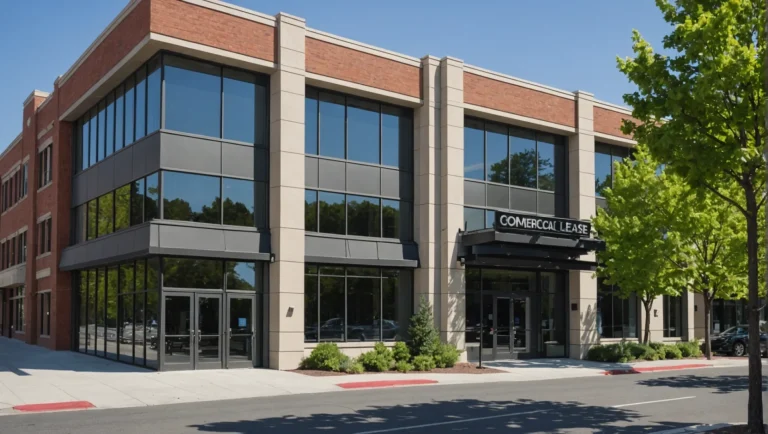Are you considering leasing a commercial property for your business?
Before signing on the dotted line, it’s crucial to understand the ins and outs of the leasing commercial real estate.
A commercial or business lease, is a legally binding agreement between a landlord and a tenant, outlining the terms and conditions for renting a property for business purposes. Unlike residential leases, commercial leases come with their own unique set of considerations and complexities. Streamline your commercial renting in Texas with our downloadable template for a commercial lease agreement, designed to make your transaction smoother and more efficient.
In this comprehensive guide, we’ll walk you through the key components of a commercial lease, the different types of leases available, and the essential factors to consider when negotiating your agreement. By the end, you’ll be equipped with the knowledge you need to make an informed decision for your business.
Lower your delivery costs by 23%
How we reduce costs:
- No delivery vehicle expenses
- Optimized local routes
- Pay-per-delivery model
- Average 23% delivery cost reduction
What is a Commercial Lease?
A commercial lease is a contract between a landlord and a business tenant
It outlines the terms and conditions for renting a property for business use
Commercial leases are longer and more complex than residential leases
A commercial lease is a legally binding agreement between a property owner (landlord) and a business (tenant) for the rental of a space used for commercial purposes. This contract sets out the terms and conditions of the rental arrangement, such as the lease duration, rent amount, and the rights and obligations of both parties to rent space.
Key Components of a Commercial Lease Agreements
A well-drafted commercial lease should include several essential components to ensure clarity and protect the interests of both the landlord and tenant:
Lease term
The lease term specifies the duration of the rental agreement, which can range from 1 to 10 years or more, depending on the needs of the business and the landlord’s preferences. Longer lease terms often provide more stability for the tenant and may come with more favorable conditions, such as lower rent or tenant improvement allowances.
Rent and payment terms
The commercial lease outlines the base rent amount, due dates, and any escalation clauses or rent increases over the lease term. It also specifies the method of payment and any late fees or penalties for missed payments. The average commercial rent prices vary by location, with cities like New York and San Francisco having higher average rents compared to other parts of the country.
Security deposit
Most commercial leases require the tenant to pay a security deposit, which serves to protect the landlord against potential damages or unpaid rent. The deposit amount varies based on factors such as the size of the space, the lease term, and the tenant’s creditworthiness. Typically, commercial security deposits are higher than those for residential leases. Understand how the commission on a commercial lease is calculated and what influences its rate.
Property description
The lease should provide a detailed description of the rented space, including its size, location, and any included amenities or common areas. This helps avoid confusion and ensures that both parties have a clear understanding of what is being leased.
Use clause
The use clause specifies the permitted use of the property for the tenant’s business operations. It’s crucial for tenants to ensure that their intended use aligns with local zoning laws and any restrictions set by the landlord.
Differences Between Commercial and Residential Leases
While both commercial and residential leases serve the purpose of renting a property, there are several key differences between the two:
Length of the lease: Commercial leases are typically longer than residential leases, with terms ranging from 1 to 10 years or more, compared to the standard 12-month residential lease.
Operating expenses: In many commercial leases, tenants are responsible for paying a portion of the full rent commercial property’s operating expenses, such as property taxes, insurance, and maintenance costs, in addition to the base rent. This arrangement is less common in residential leases.
Complexity and negotiation: Commercial leases often involve more complex terms and a more extensive negotiation process, as businesses have unique needs and requirements for their space.
Consumer protections: Residential leases are more heavily regulated by state laws, which provide tenants with various consumer protections. Commercial leases, on the other hand, have much fewer legal protections and built-in protections, as the parties are viewed as more sophisticated and capable of negotiating favorable terms.
Understanding the concept of a commercial lease is essential for businesses looking to rent a space for their operations. By familiarizing themselves with the key components and unique aspects of commercial leases, tenants can better navigate the leasing process and secure a space that meets their needs while protecting their interests.
Types of Commercial Leases
Commercial leases come in various forms, each with its own unique characteristics and implications for tenants and landlords.
Understanding the differences between lease types is crucial for making informed decisions and negotiating favorable terms.
Choosing the right lease type depends on factors such as business needs, financial stability, and long-term goals. It is worthwhile to explore the different lease types available to align with your business strategy. Check out the top five types of commercial leases to better understand how each can meet your specific needs.
Gross Lease
In a gross lease, the tenant pays a fixed rent, and the landlord covers all property expenses, including taxes, insurance, and maintenance. This arrangement simplifies budgeting for tenants, as they have a predictable monthly expense to pay rent. However, the base rent in a gross lease is typically higher than in other lease types to account for the landlord’s additional responsibilities. Understand the difference between net lease and gross lease to make an informed decision about which leasing structure is most advantageous for your business operations.
According to a report by the National Association of Realtors, gross leases are more common in smaller commercial properties, such as office spaces under 5,000 square feet. Approximately 60% of these smaller properties use gross leases, while only 30% of larger properties (over 50,000 square feet) use this structure. For those looking to enhance their negotiating skills, enhancing your understanding could be vital. Familiarizing yourself with key negotiation tips can empower you to secure a better deal when signing a commercial lease. Explore this insightful guide on negotiation tips for a commercial lease agreement and learn how to navigate this critical process effectively.
UK Office Market:
Office lease terms in the UK have fallen by 15% in recent years, with the average office lease length just over 1 year as of early 2023.
Net Lease
In a net lease, the tenant pays base rent plus a portion of the property’s operating expenses. There are three main types of net leases:
Single Net (N) Lease
The tenant pays base rent and property taxes, while the landlord covers insurance and maintenance costs.
Double Net (NN) Lease
The tenant pays base rent, property taxes, and insurance premiums, while the landlord has property insurance and is responsible for maintenance costs.
Triple Net (NNN) Lease
The tenant pays base rent and all property operating expenses, including taxes, insurance, and maintenance. This lease type offers the lowest base rent but requires tenants to pay more in additional expenses.
A survey by the Commercial Real Estate Development Association found that triple net leases are the most common type of net lease, accounting for approximately 35% of all commercial leases. Single net and double net and triple net leases each make up around 15% of commercial leases.
Overall Commercial Lease Rates:
The industry average commercial property lease length in the UK is 3-5 years across retail, office, and industrial sectors.
Longer-term leases of 5-10 years or more are common for organizations looking to develop properties.
Shorter 1-3 year leases provide more flexibility for startups and growing businesses, while longer leases help established companies lock in terms.
Modified Gross Lease
A modified gross lease is a hybrid of gross and net leases, where the tenant pays base rent plus some, but not all, of the property’s operating expenses. This arrangement allows for a more balanced distribution of costs between the landlord and tenant. The specific expenses covered by each party are negotiated and outlined in the lease agreement. Understanding the nuances of commercial leases before committing to an agreement is vital. To ensure you don’t overlook crucial details that may affect your business operations or financial commitments, take a moment to review what you should pay close attention to before signing any commercial lease. For a detailed breakdown, visit our comprehensive guide on key considerations in a commercial lease agreement.
Before finalizing your commercial lease, it’s essential to understand all critical clauses and commitments to avoid unforeseen issues. Overlooking certain terms can lead to financial or operational challenges down the line. For a thorough examination of important details and what to be cautious about prior to signing, check out our detailed post on important things to know in a commercial lease agreement essentials.
Being fully aware of the critical details within a commercial lease before you sign is essential. Many tenants overlook important clauses or obligations that can significantly impact their business operations and financial health. To help safeguard your interests, we recommend reviewing our detailed analysis on what to pay attention to before making a commitment. This resource provides comprehensive insights that every tenant should know. Learn more about the essential aspects of a commercial lease agreement points to watch to ensure you avoid common pitfalls.
According to a report by Cushman & Wakefield, modified gross leases have become increasingly popular in recent years, particularly in the office sector. In 2020, approximately 45% of new office leases in the United States were structured as modified gross leases, up from 35% in 2015.
Choosing the best lease type for a commercial property depends on various factors, including the tenant’s business needs, financial stability, and long-term goals. It’s essential to carefully review and negotiate the terms of any lease agreement to ensure a favorable outcome for both parties involved. When it comes to securing a successful commercial leasing experience, it is crucial to understand the various aspects of the agreement. For important elements to be aware of before signing a lease, check out this insightful post on commercial leases which delves into what key details to consider.
Before finalizing any commercial lease agreement, it is critical to thoroughly examine all clauses and provisions to avoid unexpected obligations that could affect your business. Awareness of what to pay attention to can safeguard your interests and help maintain a balanced landlord-tenant relationship. For a comprehensive overview of the critical factors that should be on your radar, refer to our detailed guide on commercial lease key considerations before signing to ensure you make an informed commitment.
Benefits of a Commercial Lease
Commercial leases offer secure, predictable spaces for businesses to operate and grow
Tenants can often customize the space to suit their specific needs
Rent payments on commercial leases are typically tax-deductible, reducing overall costs
Secure and Predictable Business Space
One of the primary benefits of a commercial lease is the stability it provides for businesses. When you sign a commercial lease, you are entering into a legally binding agreement with the landlord that guarantees your right to occupy the space for a set period of time, usually several years. This ensures that your business has a stable location from which to operate, without the risk of unexpected rent increases or the need to relocate on short notice.
Having a predictable business space allows for long-term planning and growth. You can make investments in your business, such as purchasing equipment or hiring staff, with the confidence that you will have a place to operate for the duration of your lease. This stability is particularly important for businesses that rely on a physical location, such as retail stores, restaurants, or manufacturing facilities.
Potential for Customization
Another advantage of commercial leases is the ability to customize the space to suit your business needs. Unlike residential rentals, where tenants are often limited in the changes they can make to the property, many commercial leases allow for significant modifications. This can include things like installing specialized equipment, reconfiguring the layout of the space, or even making structural changes to the building.
In some cases, landlords may offer tenant improvement allowances as part of the lease agreement. These allowances are funds provided by the landlord to help cover the cost of modifications or improvements to the space. This can be a significant benefit for businesses, as it reduces the upfront costs associated with setting up a new location or adapting an existing space to meet their needs.
Tax Benefits
Leasing commercial space can also provide tax benefits for businesses. In most cases, rent payments on commercial leases are considered a business expense and are therefore tax-deductible. This means that you can deduct the cost of your rent from your taxable income, reducing your overall tax liability.
For example, if your business pays $50,000 per year in rent and has a marginal tax rate of 25%, you could save $12,500 on your taxes by deducting your rent payments. This can be a significant savings, particularly for businesses with high rental costs.
Depreciation Benefits
In addition to deducting rent payments, businesses may also be able to claim depreciation on certain leasehold improvements. If you make permanent improvements to the leased space, such as installing new flooring or building out offices, you may be able to depreciate the cost of these improvements over the life of the lease. This can provide additional tax savings and help to offset the cost of customizing the same office space for your business needs.
Potential for Lease Renewal and Negotiation
Finally, commercial leases often include the option for renewal at the end of the initial lease term. This gives businesses the opportunity to continue operating in the same location if the space is working well for them. It also provides a point of negotiation short term lease itself, where tenants can potentially secure better terms or additional concessions from the landlord.
For example, if your business has been a reliable tenant and has contributed to the success of the property, you may be able to negotiate a lower rental rate or additional tenant improvement allowances upon renewal. This can help to reduce costs and ensure that the space continues to meet your business needs over time.
Red Flags to Watch Out For
When signing a commercial lease, it is essential to be aware of potential red flags that can impact your business. These include:
Unclear lease terms: Ensure that all terms, including rent, lease duration, and responsibilities, are clearly outlined and understood by both parties.
Hidden fees: Be cautious of additional fees, such as maintenance costs or property taxes, that may not be immediately apparent.
Insufficient due diligence: Conduct thorough research on the property, landlord, and local market to avoid potential issues.
By understanding these benefits and potential pitfalls, businesses can make informed decisions when entering into a commercial lease agreement.
Negotiating a Commercial Lease Agreement
Factors to Consider When Negotiating a Commercial Property Lease
When negotiating a commercial lease, several key factors come into play. These include the lease term, renewal options, rent and operating expenses, tenant improvements, and alterations. Understanding these elements and their implications is crucial for securing a lease that meets your business’s needs and supports your long-term growth.
One of the most important factors is the lease term. It’s essential to seek a lease term that aligns with your business’s goals and growth plans. If you anticipate needing the space for an extended period, negotiating a longer lease term can provide stability and potentially more favorable rates. On the other hand, if your business is in a rapidly evolving industry or you’re unsure about future space requirements, a shorter lease term or the inclusion of renewal options may be more suitable.
Industrial Leases:
Industrial lease terms correlate with property size - smaller spaces under 1,000 sq ft tend to have single-year leases, while larger spaces over 20,000 sq ft average around 6.5 years.
Rent and Operating Expenses
Another critical aspect of lease negotiations is the rent and operating expenses. It’s crucial to understand the total cost of the lease, which includes not only the base rent but also any additional expenses such as property taxes, insurance, and maintenance fees. These other operating costs and expenses can significantly impact your monthly payments, so it’s essential to clarify what’s included in the lease and negotiate a rent schedule that aligns with your business’s cash flow and budget.
How to Calculate Percentage Leases?
The "natural breakpoint" for a percentage lease is calculated as the base rent divided by the percentage rent (overage percentage), e.g. $10,000 base rent / 0.07 percentage = $142,857 natural breakpoint.
When it comes to rent, there are various types of commercial leases, each with its own implications for tenants. The most common types that cover commercial leases include:
Full-Service Lease (Gross Lease)
In a full-service lease, the landlord covers all operating expenses, and the tenant pays a fixed monthly rent. This type of lease is more predictable for tenants but may result in higher overall costs.
Net Lease
In a net lease, the tenant is responsible for paying a portion or all of the operating expenses in addition to the base rent. The three main types of net leases are single net lease (N), double net (NN), and triple net (NNN), which determine the extent of the tenant’s responsibility for expenses.
Modified Gross Lease
A modified gross lease is a hybrid between a full-service and a net lease. The landlord and tenant share the responsibility for operating expenses, with the specific arrangement outlined in the lease agreement.
Tenant Improvements and Alterations
When negotiating a commercial lease, it’s important to discuss any necessary modifications or improvements to the space. Tenant improvements can range from minor alterations like painting and installing signage to more extensive renovations such as constructing walls or upgrading electrical and plumbing systems. Clarifying who will be responsible for the costs associated with these improvements is crucial.
In some cases, landlords may offer a tenant improvement allowance (TIA) to help offset the cost of customizing the space. This allowance is typically provided as a dollar amount per square foot and can be used to cover the expenses related to designing, permitting, and constructing the improvements. Negotiating a favorable TIA can significantly reduce your upfront costs and make the lease more attractive.
The Lease Rate Lowdown:
Lease rates are typically expressed as dollars per month for tangible assets or dollars per square foot per year for commercial real estate.
Percentage Leases and Retail Tenants
While not as common as other lease types, percentage leases are often used for retail tenants, particularly in shopping centers or malls. In a percentage lease, the tenant pays a base rent plus a percentage of their gross sales above a specified threshold. This arrangement allows the landlord to benefit from the tenant’s success while providing the tenant with more flexibility in their rental payments.
Standard for Percentage Leases:
The average percentage rate for percentage leases in commercial real estate is usually around 7%.
Retail tenants, such as restaurants, clothing stores, and specialty shops, are more likely to have percentage leases due to the nature of their business. The percentage rent is typically calculated on a monthly or annual basis and can vary depending on the tenant’s industry and the specific terms of the lease.
Convenience Store Average Net Leases:
Convenience shops with single tenant net leases in the U.S. had an average length of 11 years as of Q1 2023.
Negotiation Strategies and Best Practices
When negotiating a commercial lease, it’s essential to approach the process with a clear understanding of your business’s needs, budget, and long-term goals. Some key strategies and best practices include:
1. Conducting thorough market research to understand the current rental rates and lease terms in your desired location
2. Engaging the services of a commercial real estate broker or attorney who can provide expert guidance and representation during negotiations
3. Being prepared to compromise and find mutually beneficial solutions that address the needs of both the tenant and the landlord
4. Reviewing the lease agreement carefully and seeking legal advice to ensure you fully understand the terms and conditions before signing
By following these strategies and considering the crucial factors outlined above, you can navigate the commercial lease negotiation process with confidence and secure a lease that supports your business’s success.
Commercial Lease Terms to Understand
Escalation Clause
An escalation clause is a provision in a commercial lease that allows the landlord to increase the rent over time. This increase is typically based on market conditions or a fixed percentage. The purpose of an escalation clause is to help landlords keep pace with rising costs and market rates, ensuring their investment remains profitable.
Types of Escalation Clauses
There are two main types of escalation clauses:
1. Fixed percentage: The rent increases by a predetermined percentage each year, regardless of market conditions. For example, a 3% annual increase.
2. Market-based: The rent is adjusted based on the prevailing market rates for similar properties in the area. This is usually determined by a periodic market analysis.
Sublease and Assignment Provisions
Sublease and assignment provisions outline the tenant’s ability to transfer their lease obligations to another party. This is important for businesses that may need flexibility in the future, such as expanding to a larger space or relocating.
Subleasing
Subleasing allows a tenant to lease a portion or all of their space to another party while still maintaining responsibility for paying rent due for the original lease. This can help businesses offset costs if they have excess space or need to downsize.
Assignment
Assignment transfers the entire lease to another party, relieving the original tenant of their obligations. This is useful if a business is sold or needs to relocate entirely.
It’s crucial to understand the landlord’s requirements and restrictions for subleasing and assignment, as some leases may prohibit these actions or require the landlord’s approval.
Maintenance and Repair Responsibilities
A commercial or residential lease agreements should clearly specify which party is responsible for various aspects of property maintenance and repairs. This helps tenants understand their obligations and budget accordingly.
Common Tenant Responsibilities
Interior repairs and maintenance
Cleaning and janitorial services
Utilities (electricity, water, gas)
Insurance for personal property and liability
Common Landlord Responsibilities
Structural repairs (roof, foundation, exterior walls)
HVAC system maintenance
Parking lot and landscaping
Property taxes and building insurance.
Operating Expenses and Common Area Maintenance (CAM)
Operating expenses and CAM fees are costs associated with maintaining and operating the common areas of a commercial property, such as lobbies, elevators, and parking lots. These costs are typically shared among tenants based on their proportionate share of the building or commercial complex’s total square footage.
What’s Included in CAM?
Utilities for common areas
Cleaning and maintenance of common areas
Parking lot and landscaping upkeep
Property management fees
Security services
It’s essential to understand how these and other costs that are calculated and allocated, as well as any caps or exclusions that may apply. Tenants should also be aware of their right to audit CAM fees to ensure accuracy and transparency.
Tenant Improvements and Alterations
Tenant improvements refer to the customization of a commercial space to suit a tenant’s specific needs. The lease should outline the scope of permitted alterations, the approval process, and who is responsible for the costs.
Tenant Improvement Allowance
Some landlords offer a tenant improvement allowance (TIA), which is a set amount of money provided to the tenant to cover the costs of initial alterations. The TIA is typically expressed as a dollar amount per square foot and may be subject to certain conditions or restrictions.
Restoration Clauses
A restoration clause requires the tenant to return the space to its original condition at the end of the lease term. This can be a significant expense, so tenants should negotiate to limit their restoration obligations or seek alternatives, such as a cash settlement.
By understanding these key commercial lease terms, businesses can make informed decisions and protect their interests when negotiating a lease. It’s always advisable to work with experienced legal and real estate professionals to ensure the best possible outcome.
Navigating Your Commercial Lease Journey
Commercial leases are complex agreements that require careful consideration. Understanding the different types of commercial property leases used, their key components, and the negotiation process is essential for securing a favorable agreement.
Investing time in researching and negotiating your commercial lease can lead to a more stable and predictable business environment, potential cost savings, and opportunities for growth.
Are you prepared to take the next steps in securing the right commercial lease for your business? Consider consulting with a legal professional or real estate expert to guide you through the process and ensure your interests are protected.
With the right knowledge and support, you can confidently navigate the world of commercial leases and set your small business owners up for long-term success.














